Impact of Heating Duration on Viscosity Characteristics in Cassava and Millet Flour Mixtures
| Received 05 Jul, 2024 |
Accepted 17 Sep, 2024 |
Published 18 Sep, 2024 |
Background and Objective: Viscosity is a key rheological parameter that significantly influences the quality and sensory characteristics of flour-based products. This study examines how heating time affects the viscosity profiles of cassava (CS) and millet (ML) flour blends. Materials and Methods: The investigation included blends with varying ratios of cassava and millet flours, ranging from 100% cassava flour to 100% millet flour, as well as intermediate ratios (90:10, 80:20, 70:30, 50:50 and 30:70 cassava to millet flour). Each sample’s viscosity was measured under different heating times to understand the impact of heating on the rheological behavior of the blends. Statistical analysis was conducted using the BMDP statistical software, with the BMDP 2R program utilized for stepwise multiple regression. Results were presented as the average of three independent analyses. The results of the blends were obtained at a significance level of p<0.05. Results: The results showed distinct viscosity profiles for each blend, with notable variations based on the cassava and millet flour proportions and the heating duration. Blends with higher cassava flour content generally exhibited higher viscosities, while prolonged heating led to changes in viscosity levels. Conclusion: This analysis offers valuable insights into the rheological properties of cassava and millet flour blends, aiding in optimizing processing parameters to produce flour-based food products with desired textures and quality attributes.
INTRODUCTION
The rheological properties of flour-based products are essential factors that determine their quality, texture and sensory characteristics. Understanding how various factors, including heating time, affect the viscosity profiles of flour blends is crucial for optimizing processing conditions and achieving desired product characteristics1-6. This study examines the impact of heating time on the viscosity profiles of cassava and millet flour blends.
Cassava (Manihot esculenta) and millet (Panicum miliaceum) are essential staple crops extensi vely consumed in regions where they are cultivated. These grains are prized for their nutritional benefits, cost-effectiveness and versatility in different culinary uses7-14. Combining cassava and millet flours can yield products with enhanced nutritional value, texture and functional properties15-17.
The purpose of this study is to clarify the effect of heating time on the viscosity of blends made from cassava and millet flours. Viscosity, which measures a fluid’s resistance to flow, is critical in food processing because it influences mixing, pumping and spreading. By methodically altering heating times and observing the resulting changes in viscosity, this study seeks to understand the rheological characteristics of these flour blends and fine-tune their processing conditions18-20.
This investigation examines the viscosity profiles of different cassava and millet flour blends subjected to various heating conditions. By assessing the rheological properties of these blends, we aim to determine the ideal heating time to achieve specific viscosity levels and texture characteristics in flour-based products21,22. This study investigates how heating time affects the viscosity profiles of cassava (CS) and millet (ML) flour blends.
MATERIALS AND METHODS
Study area and sites: Benin City is a significant urban hub located in Edo State, Nigeria. It is positioned approximately at 6.34°N Latitude and 5.63°E Longitude, with an elevation of about 88 m above sea level. The city boasts a population estimated at around 1,125,058 residents, making it the most densely populated city in Edo State23,24.
Sample collection and analysis
Cassava flour: Mature cassava roots, weighing 25 kg and aged over twelve months, were harvested from a farm located within the Department of Agricultural Science Education at the College of Education, Ekiadolor-Benin, Edo State, Nigeria. This study was conducted from February, 2021 to July, 2021. The cassava roots were carefully cleaned to remove sand and soil, peeled using stainless knives and washed thoroughly to remove any remaining dirt. The tubers were then sliced into smaller pieces and spread out on a clean, flat surface for air and sun drying. This drying process facilitated fermentation and reduced the moisture content. Once the cassava chips were adequately dried, they were processed through dry milling. The milled dried cassava chips, now cassava flour, were sieved to reduce the fiber content. The sieved cassava flour was carefully packed in air-tight containers in powdered form for use as samples in the research, characterized by its white color. Additionally, millet grains were sourced from Uselu market, Benin City, Edo State, Nigeria. These grains underwent thorough physical examination, sorting, cleaning and drying processes before being ground into powdered form at the mill, resulting in whole millet flour. This whole millet flour was then packed in air-tight containers and used as samples in the research. The whole millet flour exhibited a pale green color25,26.
Preparation of composite cassava flour and incorporation with millet flour: Composite cassava flour was prepared using the straight dough method outlined by Imoisi and Iyasele26,27. Weighing of cassava, wheat and millet flour was conducted using a laboratory scale. The dough was mixed to achieve optimal consistency in a mixer operating at low speed (85 rpm) for 1 min. Substitutions of cassava flour with millet flour ranged from 0 to 100% in the following proportions: CS/ML (100/0%), CS/ML (90/10%), CS/ML (80/20%), CS/ML (70/30%), CS/ML (50/50%), CS/ML (30/70%) and CS/ML (0/100%) as detailed in Table 1.
Rheological determination of composite cassava flour and millet flour
Tools and equipment manufacturers: The equipment utilized in this study, including the viscometer, rheometer and various other tools, were sourced from manufacturers such as Hanna Instruments (Woonsocket, Rhode Island, USA), Thermo Fisher Scientific (Waltham, Massachusetts, USA) and Mettler Toledo (Columbus, Ohio, USA), among other reputable suppliers.
| Table 1: | Incorporation of cassava flour with millet | |||
| Sample code | Classification |
| CS/ML (100/0%) | Control (100 g cassava flour) |
| CS/ML (90/10%) | 90% cassava flour+10% millet flour |
| CS/ML (80/20%) | 80% cassava flour+20% millet flour |
| CS/ML (70/30%) | 70% cassava flour+30% millet flour |
| CS/ML (50/50%) | 50% cassava flour+50% millet flour |
| CS/ML (30/70%) | 30% cassava flour+70% millet flour |
| CS/ML (0/100%) | 100% millet flour |
Viscometer or rheometer: A viscometer or rheometer was utilized to determine the viscosity of the flour blends. The choice of instrument was based on the anticipated viscosity range of the samples and the necessary precision of the measurements. Prior to use, the instrument was calibrated according to the manufacturer’s instructions.
Temperature control: The viscometer or rheometer was set up in a temperature-controlled environment to maintain consistent temperature conditions throughout the analysis. Depending on the instrument’s design, this setup included a water bath, temperature-controlled chamber or an integrated heating/cooling system.
Experimental procedure: A small amount of the prepared flour blend sample was placed onto the instrument’s measuring platform or spindle. The instrument settings were adjusted to the required parameters, such as shear rate (if applicable) and measurement duration. The measurement process began with the instrument applying a controlled shear force to the sample and recording the resulting viscosity.
Data collection: The viscosity of the samples was measured at regular intervals or specific time points during the heating process. The instrument was configured to allow for real-time or continuous data collection, ensuring the acquisition of accurate viscosity profiles.
Heating time variation: Each sample was subjected to different heating durations as per the experimental design. Viscosity measurements were taken at each designated heating time interval to track changes in viscosity throughout the experiment.
Data analysis: The collected viscosity data was analyzed using software provided by the instrument manufacturer or other compatible data analysis tools. Viscosity profiles were plotted to show the changes over time for each flour blend sample as a function of heating duration. Additionally, relevant rheological parameters, such as shear stress, shear rate and apparent viscosity, were calculated for further analysis.
Interpretation and reporting: The viscosity profiles were analyzed for the study’s goals and hypotheses. Trends, variations, or commonalities between the different blends of wheat flour and watermelon rind flour at various heating times were thoroughly examined. The results were presented with detailed statistical analyses and visual representations to support the findings.
Quality control and validation: The instrument performance was consistently verified through periodic calibration and the use of reference standards. Stringent quality control procedures were applied to guarantee the accuracy and consistency of the viscosity measurements.
Statistical analysis: Statistical analysis was conducted using the BMDP statistical software, with the BMDP 2R program utilized for stepwise multiple regression. Results were presented as the average of three independent analyses28,29.
RESULTS
The study depicted the impact of heating duration on the viscosity of a sample comprising 100% cassava flour (CS/ML). It offered insights into the viscosity behavior of pure cassava flour across different heating conditions as shown in Fig. 1.
Figure 2, investigated the impact of heating duration on viscosity using a sample containing 100% millet flour (CS/ML). It highlights the viscosity properties of pure millet flour across various heating periods.
Figure 3, examination of the impact of heating duration on the viscosity of a blend comprising 90% cassava flour and 10% millet flour (CS/ML). This figure analyzes the changes in viscosity due to the inclusion of millet flour in the blend, contrasting with the viscosity profile of pure cassava flour.
Figure 4, exploration of heating time effects on viscosity in a blend comprising 80% cassava flour and 20% millet flour (CS/ML). This figure examines how adjusting the cassava-to-millet flour ratio influences the rheological properties of the blend during heating.
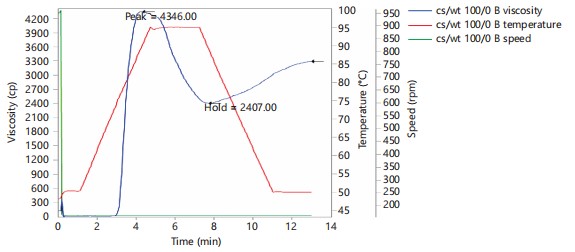
|

|
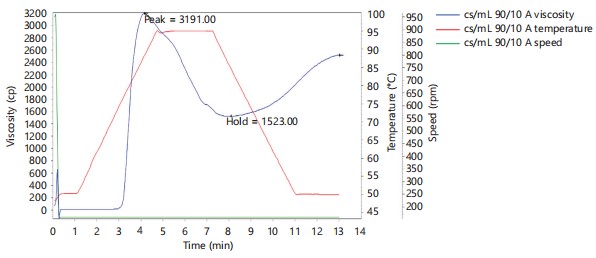
|
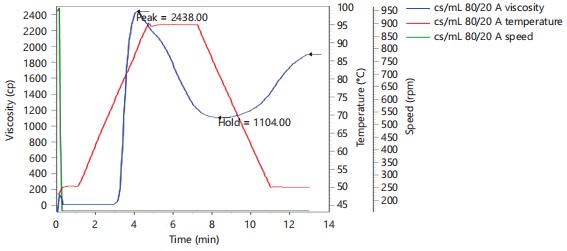
|
Figure 5, influence of heating time on viscosity in sample CS/ML (70% cassava flour and 30% millet flour). This figure examines how heating time affects viscosity, illustrating changes in viscosity based on different ratios of cassava to millet flour in the blend.
Figure 6, influence of heating time on the viscosity of sample CS/ML (50% cassava flour and 50% millet flour). The X-axis represents "heating time" (independent variable), while the Y-axis denotes “viscosity” (dependent variable), measured in units appropriate for viscosity (e.g., centipoise or pascal-seconds).
Figure 7, explores the viscosity profile of a blend consisting of 30% cassava flour and 70% millet flour (CS/ML), specifically examining how heating time affects viscosity. This figure provides insights into how the higher proportion of millet flour influences the rheological properties of the blend during heating.
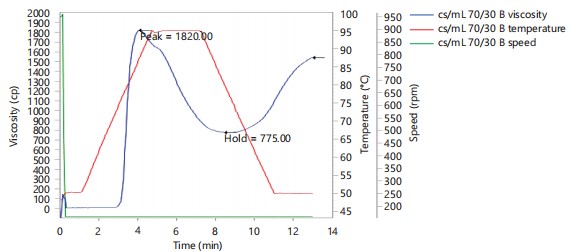
|

|
DISCUSSION
The rheological behavior of flour blends containing cassava (CS) and millet (ML) flours, observed across different heating durations, provides essential insights into their viscosity profiles. This exploration is pivotal for assessing their applicability in diverse food contexts30-34.
Beginning with Fig. 1-2, which illustrate the viscosity of 100% cassava and millet flour samples, respectively, distinct rheological properties specific to each flour type are evident. Cassava flour is known for its elevated viscosity attributed to its high starch content and distinctive granular structure. In contrast, millet flour, characterized by finer particle size and lower starch content, typically displays lower viscosity. These distinctions underscore the critical role of flour type in food formulation to achieve desired product attributes35-37.
Figures 3-7 investigate the viscosity variations in blends containing cassava and millet flours with different compositions and heating durations. As the ratio of cassava flour decreases and millet flour increases in the blends, a gradual decrease in viscosity is noted. This phenomenon is likely due to the dilution effect caused by the lower viscosity of millet flour blending with the higher viscosity of cassava flour. Additionally, prolonged heating durations could potentially alter the starch structure, influencing viscosity changes38-43.
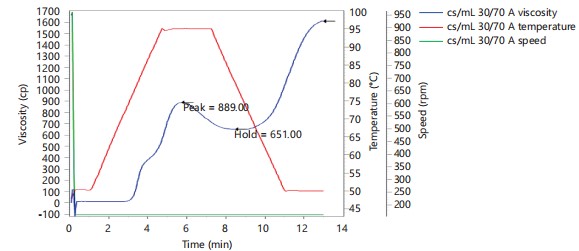
|
Blends where cassava flour predominates (Fig. 3-4) typically show elevated viscosities, aligning with the characteristics of pure cassava flour. Conversely, as the proportion of millet flour rises (Fig. 5-7), viscosity declines due to the dilution effect previously discussed. Importantly, the rate at which viscosity changes can vary based on the exact composition and heating parameters, evident from the distinct slopes observed in the viscosity profiles44-46.
In conclusion, this thorough examination underscores the complex interactions among flour composition, heating duration and viscosity within CS/ML flour blends. This understanding is crucial for refining processing conditions and developing flour-based products that meet specific criteria for texture, mouthfeel and sensory experience. Moreover, these insights advance the utilization of cassava and millet flours across various food applications, addressing both nutritional and functional requirements47-50.
CONCLUSION AND RECOMMENDATIONS
In summary, this study explores the effect of heating time on the viscosity of cassava (CS) and millet (ML) flour blends. It reveals that cassava flour generally has higher viscosity compared to millet flour, which decreases viscosity as its proportion increases in the blends. The research also shows that longer heating times typically reduce viscosity, though this effect varies with different flour compositions. These findings highlight the need to optimize heating conditions and flour blend ratios to achieve desired product textures and sensory qualities in food processing. This study recommends and enhances the use of cassava and millet flours in various culinary applications.
SIGNIFICANCE STATEMENT
Investigating how heating time influences the viscosity of cassava and millet flour blends is crucial for enhancing food processing methods and product quality. This study explores the rheological properties of these flour mixtures, demonstrating the effect of heat on their viscosity. By examining various compositions, ranging from pure cassava flour to different ratios of cassava and millet flour, the study reveals the connection between heating time, flour composition and viscosity. These findings assist in optimizing processing parameters, enabling food scientists to develop innovative products with the desired sensory characteristics. This research contributes to food science and technology by providing valuable insights for creating high-quality products based on cassava and millet flour.
ACKNOWLEDGMENTS
The author would like to thank the Department of Chemistry, University of Benin, Benin City and Prof. J.U. Iyasele of the Department of Chemistry, University of Benin, Benin City for his impactful, insightful and invaluable contributions.
REFERENCES
- Afoakwa, E.O., E.J. Kongor, G.A. Annor and R. Adjonu, 2010. Acidification and starch behaviour during co-fermentation of cassava (Manihot esculenta Crantz) and soybean (Glycine max Merr) into gari, an African fermented food. Int. J. Food Sci. Nutr., 61: 449-462.
- Agbon, C.A., E.O. Ngozi and O.O. Onabanjo, 2010. Production and nutrient composition of fufu made from a mixture of cassava and cowpea flours. J. Culinary Sci. Technol., 8: 147-157.
- Chinyere, I. and I.U. Julius, 2020. Spectroscopic determination of sugar components of Vitex doniana fruit syrup following derivatization. Nat. Sci., 18: 67-76.
- Jitngarmkusol, S., J. Hongsuwankul and K. Tananuwong, 2008. Chemical compositions, functional properties, and microstructure of defatted macadamia flours. Food Chem., 110: 23-30.
- Ceballos, H., T. Sánchez, N. Morante, M. Fregene and D. Dufour et al., 2007. Discovery of an amylose-free starch mutant in cassava (Manihot esculenta Crantz). J. Agric. Food Chem., 55: 7469-7476.
- Imoisi, C., J.U. Iyasele and S.E. Okhale, 2021. Proximate and acute toxicity profile of Vitex doniana (black plum) fruit. J. Chem. Soc. Nigeria, 46: 276-282.
- Imoisi, C., F.I. Omenai and J.U. Iyasele, 2024. Proximate composition and pasting properties of composite flours from cassava (Manihot esculenta) and millet (Panicum miliaceum). Trends Appl. Sci. Res., 19: 145-155.
- Imoisi, C., J.U. Iyasele, E.E. Imhontu, U.R. Orji and S.A. Okhale, 2021. Phytochemical and antioxidant capability of Vitex doniana (black plum) fruit. J. Chem. Soc. Nigeria, 46: 191-196.
- Charles, A.L., Y.H. Chang, W.C. Ko, K. Sriroth and T.C. Huang, 2004. Some physical and chemical properties of starch isolates of cassava genotypes. Starch, 56: 413-418.
- Egbeneje, V.O., S.E. Okhale, C. Imoisi, I.O. Ogbogo and O. Ojo, 2023. Evaluation of the inhibitive properties of silver nanoparticles in Senna occidentalis root extract as corrosion inhibitor of mild steel. Tanzania J. Sci., 49: 655-663.
- Curvelo, A.A.S., A.J.F. de Carvalho and J.A.M. Agnelli, 2001. Thermoplastic starch-cellulosic fibers composites: Preliminary results. Carbohydr. Polym., 45: 183-188.
- Okhale, S.E., N. Amuzie, C. Imoisi and J.A. Ibrahim, 2022. Phytochemical and HPLC-UV-DAD chromatographic characterization of stem bark extracts of Pentaclethra macrophylla Benth used for management of diabetes mellitus in Nigeria. N. Y. Sci. J., 15: 41-49.
- Imoisi, C., J.U. Iyasele, U.C. Michael and E.E. Imhontu, 2020. The effects of watermelon rind flour on the functional and proximate properties of wheat bread. J. Chem. Soc. Nigeria, 45: 978-986.
- Ajenu, C.O., C. Imoisi, E.E. Imhontu and U.R. Orji, 2021. Comparative evaluation of the proximate and micro-nutritional benefits of pawpaw, carrot, turmeric and coconut. J. Food Technol. Nutr. Sci., 3: 1-5.
- Daramola, B. and K.O. Falade, 2006. Enhancement of agronomical values: Upstream and downstream opportunities for starch and starch adjuncts. Afr. J. Biotechnol., 5: 2488-2494.
- Josiah, J.G., J.Y. Adama, Z. Jiya, O.M. Abah and C. Imoisi, 2023. In vitro anthelmintic activities of stem and root barks extracts of Parkia biglobosa on infective larvae and adult of Haemonchus contortus. Afr. J. Biotechnol., 22: 26-38.
- Ozoh, C.A., C. Imoisi and J.U. Iyasele, 2023. Effect of pH and duration of fermentation on the quality characteristics of garri. Pak. J. Nutr., 22: 45-51.
- Imoisi, C., J.U. Iyasele, D.O. Ikpahwore and A.O. Okpebho, 2023. The effects of watermelon rind flour on the proximate properties of wheat cake. Int. J. Nutr. Res. Health, 2.
- Okhale, S.E., I. Chinyere, S.A. Fidelis and M.I. Aboh, 2021. Antiproliferative, growth inhibitory and antibacterial activities of thymol isolated from the leaf of Ocimum gratissimum L. Life Sci. J., 18: 67-76.
- Kurhade, A., S. Patil, S.K. Sonawane, J.S. Waghmare and S.S. Arya, 2016. Effect of banana peel powder on bioactive constituents and microstructural quality of chapatti: Unleavened Indian flat bread. J. Food Meas. Charact., 10: 32-41.
- Butt, M.S. and R. Batool, 2010. Nutritional and functional properties of some promising legumes protein isolates. Pak. J. Nutr., 9: 373-379.
- Okhale, S.E., P.O. Oladosu, M.I. Aboh, C. Imoisi and J.J. Gana, 2022. In-vitro evaluation of Eucalyptus citriodora leaf essential oil and extracts on selected pathogens implicated in respiratory tract infections. Int. J. Pharmacogn., 9: 195-201.
- Omenai, F.I., C. Imoisi and J.U. Iyasele, 2024. Physico-chemical and pasting characteristics of cassava, wheat flours and their composite blends. Asian Sci. Bull., 2: 333-344.
- Umanya, O.J., P.I. Edogun and C. Imoisi, 2024. Comparative study of chitosan and alum for water purification: A case study of Jesse River, Nigeria. Trends Appl. Sci. Res., 19: 104-111.
- Imoisi, C., D.O. Ikpahwore and J.U. Iyasele, 2024. Investigation of heating time effects on viscosity profiles of wheat flour and watermelon flour blends. Singapore J. Sci. Res., 14: 13-23.
- Imoisi, C. and J.U. Iyasele, 2024. Investigation of heating time effects on viscosity profiles of cassava flour and citrus flour blends. Asian J. Emerging Res., 6: 22-30.
- Imoisi, C., F.I. Omenai and J.U. Iyasele, 2024. Investigation of heating time effects on viscosity profiles of cassava flour and wheat flour blends. Res. J. Bot., 19: 10-20.
- Okhale, S.E., C. Imoisi, A. Aliyu, J.G. Josiah and V. Egbeneje, 2024. Synergistic antimicrobial activities and phytochemical analysis of leaf extracts from Sarcocephalus latifolius, Morinda lucida and Anogeissus leiocarpus. Asian Sci. Bull., 2: 425-434.
- Edogun, P.I., C. Imoisi and J.U. Iyasele, 2024. Study on the effect of Ficus exasperata aqueous leaf extract on the rate of lactic acid formation of fermented milk. Trends Appl. Sci. Res., 19: 72-82.
- Yaich, H., H. Garna, B. Bchir, S. Besbes and M. Paquot et al., 2015. Chemical composition and functional properties of dietary fibre extracted by Englyst and Prosky methods from the alga Ulva lactuca collected in Tunisia. Algal Res., 9: 65-73.
- Okhale, S.E., H.O. Egharevba, C. Imoisi, J.A. Ibrahim and I.A. Jegede, 2022. Gas Chromatography-Mass Spectrometry (GC-MS) analysis of the essential oil from Nigerian Artemisia annua L. at different growth stages. Nat. Sci., 20: 49-54.
- Chinyere, I., I.U. Julius and O.E. Samuel, 2021. Determination of the flavoring components in Vitex doniana fruit following hydrodistillation extraction. Am. J. Food Nutr., 9: 69-75.
- Daramola, B. and S.A. Osanyinlusi, 2006. Production, characterization and application of banana (Musa spp) flour in whole maize. Afr. J. Biotechnol., 5: 992-995.
- Imoisi, C., J.U. Iyasele and A.O. Okpebho, 2023. The effects of citrus vesicle flour on the functional and proximate properties of cassava bread. Pak. J. Nutr., 22: 19-26.
- Imoisi, C., J.U. Iyasele, E.E. Imhontu, D.O. Ikpahwore and A.O. Okpebho, 2020. Pasting properties of composite of cassava and wheat flours. J. Chem. Soc. Nigeria, 45: 1157-1163.
- Imoisi, C. and U.C. Michael, 2020. Comparative physicochemical and proximate analyses of different extracts of Persea americana. J. Chem. Soc. Nigeria, 45: 1139-1146.
- Ajenu, C.O., M.E. Ukhun, C. Imoisi, E.E. Imhontu, L.E. Irede and U.R. Orji, 2021. Characterization and stability studies of egusi melon seed oil (Citrullus colocynthis L.). J. Chem. Soc. Nigeria, 46: 238-244.
- Imoisi, C. and S.E. Okhale, 2024. Chemical composition analysis of Eucalyptus citriodora essential oil using GC-MS and NMR spectroscopy. Trends Agric. Sci., 3: 83-90.
- Delcour, J.A., J. Vansteelandt, M.C. Hythier and J. Abécassis, 2000. Fractionation and reconstitution experiments provide insight into the role of starch gelatinization and pasting properties in pasta quality. J. Agric. Food Chem., 48: 3774-3778.
- Aremu, M.O., O. Olaofe and E.T. Akintayo, 2007. Functional properties of some Nigerian varieties of legume seed flours and flour concentration effect on foaming and gelation properties. J. Food Technol., 5: 109-115.
- Josiah, J.G., J.Y. Adama, E.H. Edim, I. Chinyere and J. Zipporah, 2024. Acute toxicity profile of crude methanolic stem bark extract of Parkia biglobosa in West African Dwarf (Wad) goats. J. Biosci. Biotechnol. Discovery, 9: 10-22.
- Saikia, S. and C.L. Mahanta, 2016. In vitro physicochemical, phytochemical and functional properties of fiber rich fractions derived from by-products of six fruits. J. Food Sci. Technol., 53: 1496-1504.
- Okhale, S.E., V.O. Egbeneje and C. Imoisi, 2021. GC-MS evaluation of palm oil as benign extraction medium for bioactive constituents of Ocimum gratissimum L and Bryophyllum pinnatum (Lam.). J. Am. Sci., 17: 46-53.
- Macagnan, F.T., L.P. da Silva and L.H. Hecktheuer, 2016. Dietary fibre: The scientific search for an ideal definition and methodology of analysis, and its physiological importance as a carrier of bioactive compounds. Food Res. Int., 85: 144-154.
- Rolls, B.J., E.A. Bell, V.H. Castellanos, C. Mosuk, C.L. Pelkman and M.L. Thorwart, 1999. Energy density but not fat content of foods affected energy intake in lean and obese women. Am. J. Clin. Nutr., 69: 863-871.
- Blazek, J., E.P. Gilbert and L. Copeland, 2011. Effects of monoglycerides on pasting properties of wheat starch after repeated heating and cooling. J. Cereal Sci., 54: 151-159.
- Ağar, B., H. Gençcelep, F.T. Saricaoğlu and S. Turhan, 2016. Effect of sugar beet fiber concentrations on rheological properties of meat emulsions and their correlation with texture profile analysis. Food Bioprod. Process., 100: 118-131.
- Cummings, J.H. and A.M. Stephen, 2007. Carbohydrate terminology and classification. Eur. J. Clin. Nutr., 61: S5-S18.
- Okhale, S.E., I. Chinyere, M.I. Aboh and U.A. Osunkwo, 2021. Effects of semisynthetic modifications on the antimicrobial activities of ethyl acetate extract of Mitracarpus villosus (Sw.) DC aerial part. Nat. Sci., 19: 36-41.
- Ozoh, C., C. Imoisi and J.U. Iyasele, 2024. Effect of pH and duration of fermentation on the sensory, physicochemical and proximate characteristics of garri. Trends Appl. Sci. Res., 19: 156-169.
How to Cite this paper?
APA-7 Style
Imoisi,
C., Omenai,
F.I., Iyasele,
J.U., Sa'ad,
M. (2024). Impact of Heating Duration on Viscosity Characteristics in Cassava and Millet Flour Mixtures. Asian Journal of Emerging Research, 6(1), 56-65. https://doi.org/10.3923/ajer.2024.56.65
ACS Style
Imoisi,
C.; Omenai,
F.I.; Iyasele,
J.U.; Sa'ad,
M. Impact of Heating Duration on Viscosity Characteristics in Cassava and Millet Flour Mixtures. Asian J. Emerg. Res 2024, 6, 56-65. https://doi.org/10.3923/ajer.2024.56.65
AMA Style
Imoisi
C, Omenai
FI, Iyasele
JU, Sa'ad
M. Impact of Heating Duration on Viscosity Characteristics in Cassava and Millet Flour Mixtures. Asian Journal of Emerging Research. 2024; 6(1): 56-65. https://doi.org/10.3923/ajer.2024.56.65
Chicago/Turabian Style
Imoisi, Chinyere, Frederick Ideyienmhi Omenai, Julius Uche Iyasele, and Maryam Sa'ad.
2024. "Impact of Heating Duration on Viscosity Characteristics in Cassava and Millet Flour Mixtures" Asian Journal of Emerging Research 6, no. 1: 56-65. https://doi.org/10.3923/ajer.2024.56.65

This work is licensed under a Creative Commons Attribution 4.0 International License.




